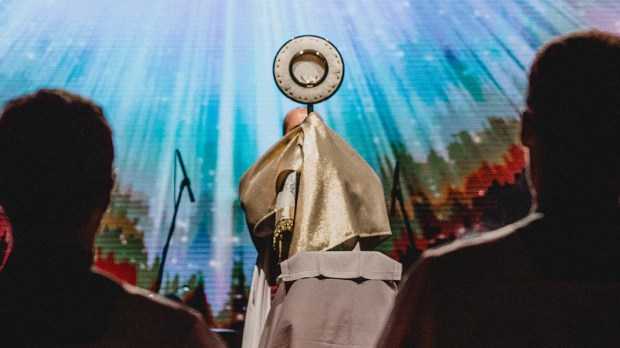The news was depressing, to say the least: A Pew Research Center poll generated headlines announcing that only 30% of American Catholics believe what the Church believes about the Eucharist — that it is the Real Presence of Jesus Christ, and not merely a symbol.
Who’s to blame for that? We all have our guesses, I’m sure — but I also know that, in a crisis, assigning blame isn’t the top priority. Stopping the crisis is.
The truth is, if we want to correct the misunderstandings about the Eucharist, the only place we can start is with ourselves and the people we can personally reach.
If each of us told five people about the Eucharist, and they each told five, and so on — well, that would start to register a big difference.
Where to start? Here are 17 suggestions.
Talk about the Eucharist in the news
It may be hard to introduce “the Eucharist” as a topic of conversation. But we all talk about the news.
1: Talk about the poll.
The Pew poll itself made news, so that’s worth talking about.
I, for one, am always wary of secular polls asking about Catholic things. So I read the poll. Pew gave Catholics two choices regarding what they believe about the bread and wine used in communion: “They become actual body and blood of Christ,” and “They are symbols of the body and blood of Christ.”
But Catholics don’t talk about “actual body and blood” — we say “Real Presence.” And Catholics do talk about how sacraments are “symbols that affect what they signify.” I wonder how it would have turned out if Pew used Catholic language in the poll, asking about “Real Presence” vs. “merely symbols”? (Actually, these Catholic researchers had the same thought.)
2: Talk about Satanic Mass stories.
Anyway, talk about the poll. And talk about other news stories about the Eucharist. Satanists, it seems, have real faith in the Eucharist, as the recent Oklahoma City case attests.
Or talk about other recent attacks on the Eucharist.
3: Talk about Eucharistic miracles.
Another great conversation topic is Eucharistic miracles. Astounding stories spotlight Jesus’ Real Presence — both from history and from our own time.
Talk about your personal experience
What is most convincing, however, is your own life.
4: Mention your own Sunday Mass experience.
When a coworker asks “So, what did you do this weekend?” have you ever considered answering something like, “We were crazy busy, but you know what? Mass was amazing. I love Sunday Mass. The homily isn’t always great, but the Eucharist gives me such peace”?
5: Share your personal story.
Or, when conversations turn to swapping life stories, have you ever considered mentioning the most important thing in your life: The Real Presence of Jesus Christ in the Eucharist?
“I loved my first Communion,” begins one story. “I stopped going to Mass for years, and it was great to be back,” goes another. Or maybe you have more dramatic ones. (I do.)
6: Show off your kids’ First Communion photos.
We display graduation pictures, sports pictures, performance pictures — why not show those great pictures of your kids dressed up for First Communion in the pictures on the mantelpiece? Then explain why that day is special.
Post your Eucharistic faith on social media
Social media is a powerful tool that no previous generation had. Use it for Jesus.
7: Post requests for Holy Hour prayer intentions (do it a day in advance!).
I always love when people do this. I am also always frustrated when I notice that they posted the request five hours ago and that they’re back home already.
8: Post about your family’s First Communion anniversaries as you do wedding anniversaries.
See No. 6 above. These are great pictures.
9: Post Aleteia stories about the Eucharist.
Everyone has their favorite. I love “She was headed to adoration at 3 a.m. when 6 armed men stopped her,” “Scouts in Adoration,” the dying priest’s first Mass in the hospital, and, of course, “How One Adoration Chapel Touched Countless Lives.”
Invite someone to encounter the Eucharist
There are many non-threatening ways to introduce the Eucharist.
10: Show a Eucharistic movie.
Do you watch movies with people? Watch one of these.
11: Read a Eucharistic novel.
Do you have a book club? Sneak in Brideshead Revisited, The Power and the Glory, or anything by Flannery O’Connor, then quote her saying of the Eucharist “If it’s just a symbol, to hell with it!”
12: Invite someone to Mass!
Back when we lived in a bigger city, we used to invite someone to Mass once a month. You would be surprised how many people say yes. Go to breakfast afterwards to talk about what just happened.
(And tell them why you go each week.)
Personally recommit to the Eucharist
Of course, the first person to convince about the Eucharist is yourself.
13: Read up on the Real Presence.
Try Brant Pitre’s book Jesus and the Jewish Roots of the Eucharist, Scott Hahn’s The Fourth Cup or The Lamb’s Supper, or try the great Vinny Flynn’s 7 Secrets of the Eucharist and 21 Ways to Worship.
14: Get closer to Jesus in the Mass.
15: Visit Him more often — for a few minutes, or for 60.
I teach my kids what a brief tabernacle visit looks like.Holy hours are also powerful, for the old and the young. Here’s a minute-by-minute guide.
Seek intercession
Seek help! Some powerful saints can aid us.
16: Pray to the martyrs of the Eucharist.
Those who died for the Eucharist will surely want to help.
17: Pray to Eucharistic saints.
Last, seek help from saints of the Eucharist. Well, I guess that’s every saint.
But some have some great stories associating them with the Eucharist.
St. Philip Neri, pray for us!
St. Thomas Aquinas, pray for us!
St. Anthony of Padua, pray for us!
Venerable Fulton Sheen, pray for us!

